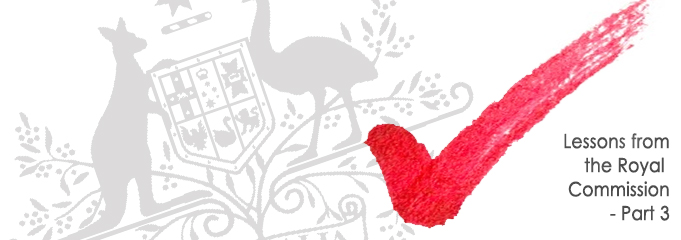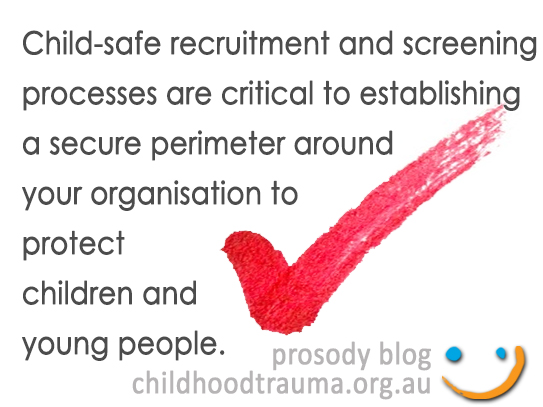
Lessons from the Royal Commission Part 3

This article was authored by David Ross,
Senior Advisor with the Safeguarding Children Program.
In this series of blogs we have outlined some important insights from the interim report of the Royal Commission into Institutional Responses into Child Sexual Abuse. We previously have written about the nature and prevalence of child sexual abuse perpetrators and organisational awareness of abuse, as well as the main risk factors for children in organisations that provide a service or activity to them. In this blog we examine issues relevant to child-safe recruitment, screening and monitoring processes.
 Child-safe recruitment and screening processes are critical to establishing a secure perimeter around your organisation to protect children and young people. Criminal History and Working with Children Clearance checks are an important part of this perimeter. However, additional systems are required to ensure that thorough screening is undertaken. These include interviews and referee checking processes that specifically address child safety issues.
Child-safe recruitment and screening processes are critical to establishing a secure perimeter around your organisation to protect children and young people. Criminal History and Working with Children Clearance checks are an important part of this perimeter. However, additional systems are required to ensure that thorough screening is undertaken. These include interviews and referee checking processes that specifically address child safety issues.
Some questions you might ask the applicant’s previous employer might include:
- Would you have any concerns about … working with children or young people?
- Do you know of any instances where … has demonstrated inappropriate touching and physical contact with children or young people?
- Do you know of any instances where … has acted outside the boundaries of his/her role?
- Have there being any findings against … in relation to allegations of inappropriate behaviour with respect to children or young people?
- Are you aware of any circumstance or action that if reported would mean the suspension of … working with children check?
 The majority of offenders will not have been previously detected by the criminal justice system or have criminal records relating to child abuse, although some may have histories of substance abuse and violence. People involved in recruitment should watch for signs or ‘red flags’ in interviews and through other recruitment processes. A ‘red flag’ can be an applicant’s focus on their own needs or ‘special relationships’ with children or unusual attitudes about children. For example the perpetrator in Case Study 2 from the Royal Commission said his career ambitions were: ‘To work with kids and help them experience life, love and friendships in an environment where there are no walls or boundaries’. In hindsight it is very easy to read into this statement what his intentions were. During an interview process, this type of statement should lead to questioning and exploration of attitudes to and understanding of the importance of professional boundaries.
The majority of offenders will not have been previously detected by the criminal justice system or have criminal records relating to child abuse, although some may have histories of substance abuse and violence. People involved in recruitment should watch for signs or ‘red flags’ in interviews and through other recruitment processes. A ‘red flag’ can be an applicant’s focus on their own needs or ‘special relationships’ with children or unusual attitudes about children. For example the perpetrator in Case Study 2 from the Royal Commission said his career ambitions were: ‘To work with kids and help them experience life, love and friendships in an environment where there are no walls or boundaries’. In hindsight it is very easy to read into this statement what his intentions were. During an interview process, this type of statement should lead to questioning and exploration of attitudes to and understanding of the importance of professional boundaries.
The Safeguarding Children Program advises organisations to ask questions in the interview that explore an applicant’s attitudes and beliefs about working with children. We have found that by asking broader questions, you can create an opportunity for exploration of attitudes. For example:
- What do you find most rewarding about working with children and young people?
- How do you think your peers, supervisors and referees would describe the way you work with children and young people?
- How would you respond to a child or young person who disclosed they were being subjected to abuse?
- What would you do if you thought another staff member or volunteer was harming a child or young person?
The ongoing supervision of staff and processes for monitoring staff performance over time are essential elements of an accredited Safeguarding Children Organisation. Supervision is facilitated by a physical environment that has good natural surveillance, line of sight to all areas, large unobstructed windows (including in sensitive places), random checks on less transparent areas and CCTV where appropriate. It is critical that staff-child interactions are supervised by trained staff.
In addition to monitoring staff performance with supervisions, we recommend the practice and implementation of regular performance reviews which include a focus on adherence to organisational policies. These reviews become a regular, formal place to address staff understanding of the requirements on them to assist in the prevention of abuse, and ensure clarity around processes for managing allegations and incidents.
An organisation which has a safeguarding children culture supports any individual to raise even minor concerns and know that those concerns will be taken seriously. It has systems that allow these small pieces of relevant information to be connected so that the patterns of behaviour we discussed in our earlier blog as being associated with grooming, are noticed and acted upon.
The final in this series of blogs about insights from the Royal Commission will discuss child-focussed interventions and organisational responses to incidents of abuse.
If you would like help to audit and update your organisations policies, please contact safeguardingchildren@childhood.org.au
